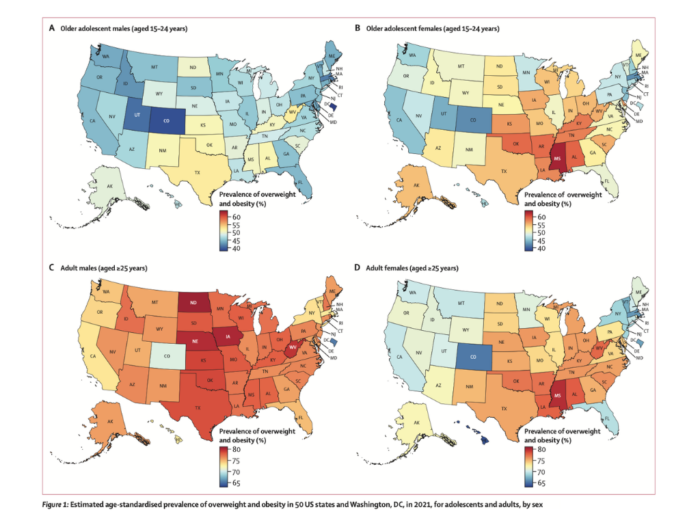
The Weight of the Nation: Insights from the Global Health Data Exchange
A recent article published in The Lancet highlights the concerning status of overweight and obesity in the United States, providing a stark look at the trajectory of this public health crisis. Not only are the numbers projected to rise, but the data also underscores a troubling reality: efforts to combat overweight and obesity over the past 30 years have been largely ineffective.
I’m no public health expert, but this clearly calls for a critical reassessment of current strategies and the adoption of a more comprehensive approach. Could this study be the wake-up call we need?
Study Overview and Data Analysis
In this study, researchers estimated the prevalence of overweight and obesity from 1990 to 2021 across age groups (5–14, 15–24, and ≥25 years) by sex, and projected overweight and obesity rates through 2050 at both national and state levels.
Obesity in adults is classified using BMI (weight÷height²). A BMI of 25–29.9 kg/m² is considered overweight, while a BMI of 30 kg/m² or higher is classified as obese. Overweight and obesity in children were determined using CDC growth chart percentiles.
The data was collected through a systematic review and literature search, drawing from sources such as NHANES, the Behavioral Risk Factor Surveillance System, the Gallup Daily Survey, and others. It included both self-reported and directly measured weights and heights.
I won’t pretend to understand statistical analysis, but for those who do, Spatiotemporal Gaussian Process Regression (ST-GPR) was used to generate a comprehensive time series. This analysis estimated the prevalence of overweight and obesity, as well as the proportion of individuals with obesity within the overweight population. Forecasts were generated based on a reference scenario that assumes the continuation of historical trends and relationships.
Key Study Findings
Frankly, the findings were shocking but not surprising. Baseline data for 2021 suggests that:
- An estimated 15.1 million children (36%, ages 5–14) and 21.4 million adolescents (nearly 50%, ages 15–24) in the USA were classified as having overweight or obesity.
- Among adults over 25 years old, nearly 172 million individuals—or approximately 75%—are classified as overweight or obese.
- Texas, Mississippi, Oklahoma, Nebraska, and West Virginia had the highest prevalence of overweight and obesity across all age and gender groups.
Assuming past trends and patterns continue, researchers forecast the following trends in overweight and obesity prevalence by 2050:
- In children (ages 5–14), overweight and obesity to reach 45%.
- Adolescents (ages 14–24), overweight and obesity to reach 57%.
- Among adults, overweight and obesity is projected to effect 213 million—or 82% of the population.
- The highest prevalence of overweight and obesity is forecasted in West Virginia, followed by Kentucky and Iowa.
- Colorado, my home state, is projected to experience the greatest relative change.
Projected Health Impact
What does this mean for the future health of our nation? Unfortunately, the outlook is not promising.
By 2050, 1-in-5 children, 1-in-3 adolescents, and 2-in-3 adults are expected to have obesity—with the highest levels continuing to be concentrated in southern U.S. Without immediate action, researchers warn of an escalating crisis of overweight and obesity across the entire country, accompanied by severe health, social, and economic consequences.
A projection study published by the ADA in 2001 estimated the prevalence of type 2 diabetes at 36%, but this figure is likely an underestimate based on this new and emerging forecast.
Personal vs. Societal Responsibility
One key point researchers emphasize in their discussion is that the projected increase in overweight and obesity, especially among children, extends far beyond the scope of personal responsibility.
In the past three decades, the USA has undergone extensive economic, demographic, and technological transitions that have triggered profound changes to agriculture practices, food security, food supply systems, commercialization, urbanization, densification, neighborhood livability, sedentariness, and wealth and educational inequalities, coupled with underlying structural racism and gender inequalities, that all interact to drive population-wide obesity.
Preventing new cases of childhood obesity should be a priority, with a focus on investing in preconception and perinatal interventions to break the intergenerational cycle.
Defining Our Role
Whether you are a clinical practitioner (RD, RN, CDCES, physician, etc.), an administrator, a public health professional, a policymaker, or an individual living with overweight or obesity—each of us has a role to play.
At home, I consider the messages and behaviors I model for my son. I lean into the impact of my purchasing decisions at the grocery store and the influence of my vote in local and state elections. I try to support community initiatives that promote healthy lifestyles. In my clinical practice, I strive to take a holistic approach that acknowledges the complexities of weight management, focusing on support rather than blame or judgment.
I encourage you to reflect on where you can make the greatest impact in addressing this epidemic. Reversing the current trajectory will require bold ideas and a collective effort.
- Ng M, Dai X, Cogen RM, et al. National-level and state-level prevalence of overweight and obesity among children, adolescents, and adults in the USA, 1990–2021, and forecasts up to 2050. The Lancet. Published online November 2024:S0140673624015484. doi:10.1016/S0140-6736(24)01548-4
- Boyle JP, Honeycutt AA, Narayan KMV, et al. Projection of diabetes burden through 2050. Diabetes Care. 2001;24(11):1936-1940. doi:10.2337/diacare.24.11.1936


You May Also Like

Happy National Nutrition Month!
March 5, 2023
GLP-1 Therapy Part 3: Strategies for Successful Weight Loss
April 22, 2025

